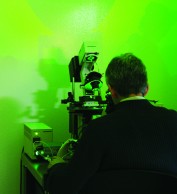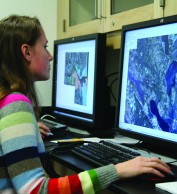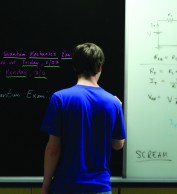STILLPOINT Archive: last updated 03/20/2009
1. A Microengraving Microscope
Gordon has a new Olympus IX-81 inverted fluorescent microscope. This state-of-the-art microscope will be used to image fluorescently labeled cells as part of Dr. Craig Story’s microengraving research--the focus of his recent sabbatical at the Whitehead Institute for Biomedical Research in Cambridge. The microscope is also equipped with a motorized stage and micromanipulator, which allows the retrieval of cells for preservation or expansion.
Microengraving provides an extraordinarily detailed snapshot of how thousands of single immune cells respond to vaccination by separating each cell into a microscopic chamber and collecting its secretions for analysis. With this new technology, vaccines can be researched and made available far more quickly than in the past. Biology and chemistry students have participated in Story’s research by cataloging cells, conducting protein analyses and running Western blots to analyze hepatitis B antibodies obtained by microengraving.
2. A Dedicated Engineering Lab
The new Robert W. Bowden Engineering Lab in the Ken Olsen Science Center is now in use by students in Gordon’s 3-2 engineering and physics programs. “The flexibility and capabilities built into the space will serve our students well for years to come,” said David S. Lee, associate professor of physics, department chair and 3-2 engineering program coordinator. Among the many notable features of the facility are the 64 linear feet of sliding glass markerboards and porcelain-coated steel whiteboards; plenty of room for group problem-solving sessions, complex equations and graphical illustrations. “I don’t have to spend class time erasing, and students can snap a cell phone picture of a board for later reference,” Lee said. The student here is tackling quantum mechanics. Soon afterward the boards were covered with design ideas for a wireless, joystick-controlled Lego robot.
3. Global Ecosystems--A New View
Most jobs in ecology or environmental science require knowledge of the geographic information system (GIS). Students interested in landscape ecology or conservation biology can use new computers and massive flat screen monitors to analyze global ecosystems in the Ken Olsen Science Center. By downloading digital satellite images from the Internet from anywhere in the world, they are able to link broad-scale processes to data collected in the field.
This tool is valuable for class projects. Students in Landscape Ecology and GIS were able to look at purple loosestrife distribution as it is affected by vegetation changes along the Merrimac River; or chipmunk behavior in different ecosystems. This tool is also important for research projects; students are helping Greg Keller, associate professor of conservation biology, to link foraging behavior and abundance of declining populations of migratory songbirds to landscape fragmentation, and to compare chickadee and titmouse behavior in different habitats at a landscape scale. Gordon students are answering important questions about how humans impact natural systems.


